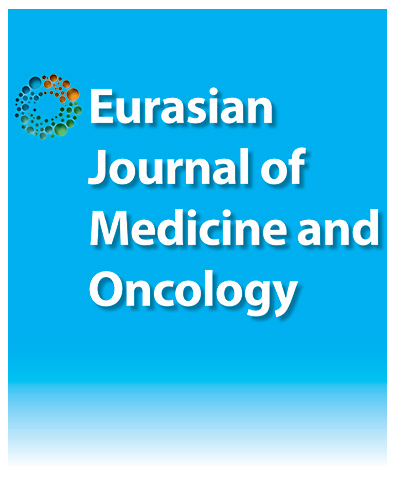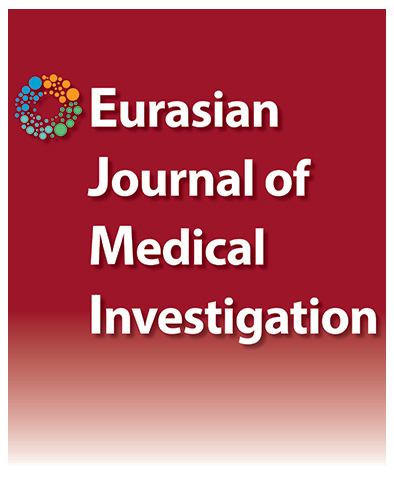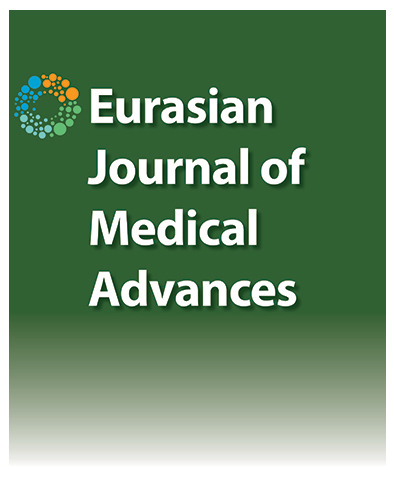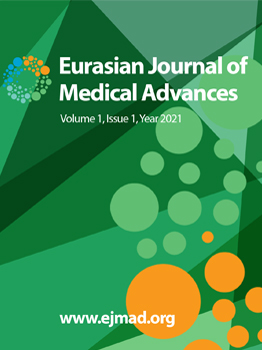Volume: 2 Issue: 2 - 2022
| REVIEW | |
| 1. | Thoracic and Abdominal Oncological Emergencies in Radiology Marco Fogante, Matteo Marcucci, Corrado Tagliati doi: 10.14744/ejma.2022.33043 Pages 23 - 29 Thoracic and abdominal acute life-threatening oncological emergencies can be secondary either an underlying cancer or a complication of its treatment. Oncological emergencies can be classified in metabolic, hematological or structural. Metabolic and hematological emergencies are diagnosed by clinical and laboratory exams. Indeed, the radiological imaging is essential for the diagnosis of structural oncological emergencies such fistulas, hemoptysis, embolism, superior vena cava syndrome, cardiac tamponade, intraabdominal hemorrhage, bowel obstruction, perforation and ischemia, intussusception and urinary tract obstruction and structural complications of the oncological treatments. Radiologists should be confident with the main findings of structural oncologic emergencies to make an accurate timely diagnosis and to provide appropriate patient care. For this reason, the purpose of this work is to summarize the main clinical and radiological characteristics of thoracic and abdominal structural oncological emergencies. |
| RESEARCH ARTICLE | |
| 2. | Factors Affecting Postoperative Morbidity and Mortality in Chronic Hemodialysis Patients Ferhat Ferhatoğlu, Murat Tuğcu, Süheyla Apaydın doi: 10.14744/ejma.2022.43153 Pages 30 - 38 Objectives: Hemodialysis (H/D) is the most common renal replacement therapy for patients with end-stage renal failure (ESRD). Although cardiac and neurological complications associated with the treatment are known to increase mortality, the effect of surgical interventions on patients is not fully elucidated. Therefore, we aimed to determine the effect of surgery on morbidity and mortality in H/D patients as a specific group. Methods: The data of 117 patients who received HD treatment for ESRD were analyzed retrospectively. Results: Among the surgical subgroups, medium-sized (43.5%), elective (66.6%) and extra-abdominal (58.1%) surgeries were performed at the highest rate. Those undergoing emergency surgery were older and had a higher rate of anemia, lower albumin levels, and higher C-reactive protein (CRP) levels compared to other groups (p<0.05). Similarly, the mean age and creatinine levels of those who underwent major surgery were higher (p<0.05). The mean age and CRP levels of those undergoing abdominal surgery were higher compared to other groups (p<0.05). The multivariate analysis has shown that advanced age, low albumin levels, and emergency, intra-abdominal and major surgeries are independent prognostic risk factors for ICU admission. Advanced age, low albumin level, and emergency surgery were the determining factors for 1-month postoperative mortality. Conclusion: Emergency, major, and intra-abdominal surgery significantly increase morbidity and mortality in chronic H/D patients. Further, hypoalbuminemia and advanced age are independent prognostic factors for higher intensive care unit admission. Preoperative elevation of albumin levels along with close postoperative follow-up may positively affect survival in these patients. |
| 3. | Berlin-Frankfurt-Munster (BFM) versus Hyperfractionated Cyclophosphamide, Vincristine, Doxorubicin, Dexamethasone (Hyper-CVAD) chemotherapy regimens in Adult T-Cell ALL and Adolescent and Young Adult (AYA) Patients Merve Özkan, Şerife Solmaz, Ahmet Seyhanlı, Müjdenur Koç, Güner Hayri Özsan, Fatih Demirkan, Zeynep Yüce, Oğuz Altungöz, Inci Alacacıoğlu doi: 10.14744/ejma.2022.70299 Pages 39 - 45 Objectives: Recently, in adult ALL patients, to improve prognosis, pediatric ALL protocols have been used in adolescent and young adults and positive results have been reported. Methods: In this study, we aimed to evaluate retrospectively the demographic features, treatment responses, cytogenetic data and survival analyses of adult T-All cases followed up by the Department of Adult Hematology at Dokuz Eylul University Hospital. Results: The mean survival time for patients receiving H-CVAD was 46.9 months (±12.9), and median survival time of patients receiving BFM treatment was 71.5 months (±11.4).The median OS of patients receiving BFM was statistically significantly longer than that of Hyper-CVAD (p=0.044). Conclusion: The use of pediatric intensive chemotherapy regimens in adolescent and young adult (AYA) patients with low incidence and poor prognosis of ALL-type T-ALL, the inclusion of nelarabine in the first line treatment and the selection of new targeted therapies based on new genomic discoveries can increase effectiveness. The use of pediatric intensive chemotherapy regimens is promising for increased survival in adults. |
| 4. | The Relationship Between Poor Glycaemic Control and Risk Factors in Patients with Type 2 Diabetes Mellitus Muhammed Mustafa Atcı, Özgül Pamukçu Cerciz, Yusuf Kayar, Fatih Borlu, Yüksel Altuntaş doi: 10.14744/ejma.2022.87597 Pages 46 - 54 Objectives: To identify risk factors for poor glycaemic control in type 2 diabetes mellitus patients. Methods: We obtained data from type 2 diabetes mellitus patients including their sociodemographic characteristics, body mass index (BMI), duration of diabetes, family history of diabetes, hypertension status, and current antidiabetic medications. At their last follow-up visits, the haemoglobin A1c (HbA1c), fasting glucose level, and lipid profiles were also recorded. Patients with a HbA1C ≥ 7% or a fasting plasma glucose level≥ 140 mg/dl were considered to have poor glycaemic control. Results: Of the 500 patients included in this study, 51.2% (n=256) were female. The average HbA1c level was 7.7% of whom 67% had a HbA1c level ≥ 7%, and 48% had a fasting plasma glucose≥ 140 mg/dl. Better glycaemic control rates (HbA1c < 7% and/or fasting plasma glucose < 140 mg/dl) were noted in patients with a shorter diabetes duration, no family history of diabetes, higher educational status, a lower waist circumference, and no hypertension, who were married and currently working, had been prescribed only oral antidiabetic agents and whose triglyceride levels were < 150 mg/dl. Independent risk factors for poor glycaemic control were longer duration of diabetes, diagnosed with diabetes at an earlier age, lower education level, higher triglyceride levels, being single and receiving insulin therapy. Conclusion: It could be suggested that waist circumference and triglyceride levels may be important parameters than BMI and cholesterol levels for glycaemic control. However, these data should be confirmed by further prospective studies. |
| 5. | Real World Evidence on the Availability of Anti-Nuclear Antibody (ANA) in Diagnosis of Connective Tissue Diseases; A Retropective Single Center Trial Polat Olgun, Veli Yazısız doi: 10.14744/ejma.2022.96268 Pages 55 - 60 Objectives: Antinuclear antibodies (ANA) are autoantibodies against the cellular compartments such as the nucleus, nucleolus, nuclear membrane and cytoplasm. Determining the significance of ANA in the diagnosis of connective tissue diseases was aimed. Methods: The test results and diagnosis of the patients who applied to Şişli Etfal Research Hospital Rheumatology outpatient clinic between June 2011 and October 2012. The sensitivity, specificity, positive and negative predictive values of IIF-ANA in the diagnosis of connective tissue diseases were also calculated. Results: It was determined that for every 1 out of 5 patients who applied to Rheumatology Outpatient Clinic, ANA test was ordered and for one third of those patients for whom the order was made, ANA test results were positive. For titres of 1/320 and higher, the specificity and positive predictive value of ANA in the diagnosis was found to be 99% and 96% respectively. For 1/100 and higher as the titer, sensitivity was 65%, specificity was 88% and positive and negative predictive values were 64% and 88% respectively. These values showed that 1/100 titer was suitable to use in screening. Conclusion: Positive ANA results, clinical findings and symptoms of the patient are important in diagnosis of connective tissue diseases. |
| 6. | Retrospective Evaluation of Patients With Iron Deficiency Anemia Who Need Parenteral Treatment; Iron Carboxymaltose ? or Iron Sucrose? Tuğba Çetintepe, Emine Durak, Lütfi Çetintepe, Şerife Solmaz, Oktay Bilgir doi: 10.14744/ejma.2022.46220 Pages 61 - 64 Objectives: According to World Health Organization, anemia is defined as the value of Hemoglobin (Hb) <13 g/dl in adult males, <12 g/dl in non-pregnant women and <11 g/dl in pregnant women. Iron deficiency anemia (IDA) is the most common cause of anemia. There are limited comparative data in the literature, regarding response to parenteral iron therapy. Data of the patients with parenteral iron therapy for IDA were retrospectively examined in this study to reveal their treatment responses. Methods: Data of 145 patients underwent parenteral iron therapy for IDA between April 2013-September 2017 at the hematology outpatient clinic of Izmir Bozyaka Training and Research Hospital were reviewed retrospectively. Pre- and post-treatment hemogram and iron parameters were evaluated with a view to examine the efficacy and adverse effects of parenteral Iron Sucrose (IS) and Iron Carboxymaltose (ICM) administrations and compare treatment responses. Results: 145 patients were included in the study,127(87.5%) female,18(12.5%) male, median age was 43.5(17-87) years. ICM was administered in 65(44.8%), IS in 80(55.2%) patients. Hemoglobin increase was 3.2 g/dl at the end of the 4th week in ICM group while 2.1 g/dl in IS group, which was not statistically significant (p=0.7). Ferritin increase in the first month of treatment displayed a statistically significance in favor of ICM.(48x104, p=0.0001). Conclusion: Both parenteral treatment options are highly effective and reliable in early response to IDA, and the increase observed in hemoglobin and ferritin levels was more prominent with ICM. |
| 7. | Nutraceutical Importance of Dietary Curcumin, Its Analogues in Restricting Melanoma Growth and Modulation of Multiple Targets Anushree Tripathi, Krishna Misra, Manoj Kumar Shrivash, Saurabh Yashaswee, Surendra Kumar Trigun doi: 10.14744/ejma.2022.02486 Pages 65 - 72 Objectives: Melanoma is one the most lethal form of skin cancer with a survival rate of less than 5% and thus possesses biggest challenge for its therapy among research scientists. The Melanoma progression within a tumor is guided by multiple mechanisms, thereby hindering the development of successful therapies. Therefore, there is a urgent demand to identify potential targets against melanoma cancer cells as well as to develop potent inhibitors in order to reduce melanoma at the very onset of cancer cell growth through targeting mutidrug resistance. It is well reported that curcumin is acting as inhibitor for metastasis of melanoma cancer cells. The most potential target of melanoma cancer cells has to be identified in order to reduce the relapse as well as to overcome multidrug drug resistance. Methods: In this study, the potency of curcumin analogues as well as their interaction with potential targets was identified by insilico approaches.Their efficacy has been examined through invitro assay. Results: Based on both invitro and insilico studies, few curcumin analogues have shown higher inhibitory activity against melanoma cancer cells than curcumin. Conclusion: The present study predicts some novel curcumin analogues that can act as potent inhibitor of melanoma cancer cells. |
| 8. | Role of 'Serial D-Dimer Level' in predicting Severity and outcome in COVID-19 pneumonia: A Prospective multicentric Observational Study of 1000 cases in Tertiary Care Setting in India Shital Patil, Abhijit Acharya, Gajanan Gondhali, Ganesh Narwade doi: 10.14744/ejma.2022.36854 Pages 73 - 80 Objectives: Covid-19 pneumonia is heterogeneous disease with variable effect on lung parenchyma, airways and vasculature. Methods: Multicentric, prospective, observational and interventional study included 1000 covid-19 cases confirmed with RT PCR. All cases were assessed with HRCT thorax, oxygen saturation, inflammatory marker as D-Dimer at entry point and follow up. Age, gender, Comorbidity and use BIPAP/NIV and outcome as with or without lung fibrosis were key observations. In selected cases, lower limb venous doppler and CT pulmonary angiography to rule out DVT or PTE. Statistical analysis is done by using Chi square test. Results: CT severity score at entry point with D-Dimer level has significant correlation.[p<0.00001] D-Dimer level has significant association with duration of illness prior to hospitalization.[p<0.00001] Comorbidities have significant association with D-Dimer level. [p<0.00001] D Dimer level has significant association with oxygen saturation.[p<0.00001] BIPAP/NIV requirement has significant association with D-Dimer level.[p<0.00001] Timing of BIPAP/NIV requirement during hospitalization has significant association with D-Dimer level.[p<0.00001] Follow-up D-Dimer titer during hospitalization as compared normal & abnormal to entry point level has significant association with post-covid lung fibrosis, deep vein thrombosis and pulmonary thromboembolism.[p<0.00001]. Conclusion: D-Dimer has documented very crucial role in covid-19 pneumonia in predicting severity of illness and assessing response to treatment during hospitalization. |
| 9. | The Relationship Between Spot Urinary Protein/Creatinine Ratio and HbA1C, Metabolic Parameters and Other Complications in Patients with Type 2 Diabetes Şaban Seçmeler, Emre Hoca, Hayriye Esra Ataoğlu doi: 10.14744/ejma.2022.29392 Pages 81 - 87 Objectives: The purpose of the study was relationship between spot urinary protein/creatinin ratio and HbA1c, metabolic parameters and other complications in patients with type 2 diabetes. Methods: The retrospective study was carried out in type 2 diabetes patients followed up for at least 2 years; during March 2016. Biochemical parameters in the last 3 visits were recorded. BMI, waist circumference and physical examination findings were recorded at the time of last visit. Patients were divided into groups according to their spot urine protein/creatinine ratios. Results: This study was consisted of 198 patients, 113 females and 85 males. The mean age was 60.6±10.68. The total outpatient clinic follow-up time was 13.02±7.2 years in the entire patient group. In 198 patients evaluated, the average of HbA1c(first, second, last) and spot urine protein/creatinine ratios(first, second, last). There was an increase in both groups but no correlation was found between these increases. When urine protein/creatinine ratios of the last control were examined, the relationship between these rates and age, urea, creatinine, GFR, total cholesterol, triglyceride, HDL, LDL, AST, ALT, CRP, HbA1c values were investigated. When the patients were compared according to their spot urine protein/creatinine ratios being <150 mg/g and >150 mg/g; metabolic syndrome was detected 2,351 times (OR) higher in second group. Conclusion: We found positive correlation between microalbuminuria and spot urinary protein/creatinine ratios. We also found a relationship between metabolic syndrome, frequency of retinopathy and spot urine protein/creatinine ratios. |
| CASE REPORT | |
| 10. | Infantile Hepatic Hemangioendothelioma with Complete Response to Propronalol Monotherapy Özlem Terzi, Hüseyin Avni Solğun, Sümeyra Doğan, Sibel Akpınar Tekgündüz, Ali Ayçiçek doi: 10.14744/ejma.2022.03522 Pages 88 - 89 Infantile Hepatic Hemangioendothelioma (IHH) is an extremely rare and painless vascular tumor. IHH is usually in benign nature but it can also be life-threatening with a rapid growth tendency. There are approaches in the treatment of IHH, ranging from drug therapy to liver transplantation. Propranolol, which is used in first-line therapy for most patients, is effective alone in the treatment. |
| 11. | How Should Immature Ovarian Teratoma with Gliomatosis Peritonei Be Treated? A Series of Three Rare Cases and Review of the Literature Yusuf Ilhan, Hasan Şenol Coşkun, Hadice Elif Peştereli, Sema Sezgin Göksu, Elif Ocak Gedik, Havva Serap Toru, Ali Murat Tatlı doi: 10.14744/ejma.2022.69875 Pages 90 - 94 Immature ovarian teratoma (IT), also called malignant ovarian teratoma, is one of the ovarian germ cell tumors. Histologically, these neoplasms are typically differantiate towards the three germ cell layers. The metastatic implantation of mature glial tissue on the surface of the peritoneum, omentum, and abdominal lymph nodes is defined as gliomatosis peritonei (GP). It is an extremely rare disease and usually associated with ovarian teratomas, especially in IT. Because of its rarity, the prognostic effect of GP is unclear. Here, we presented three different patients who were diagnosed as IT with GP, and we also reviewed the literature to understand this disease better. |






